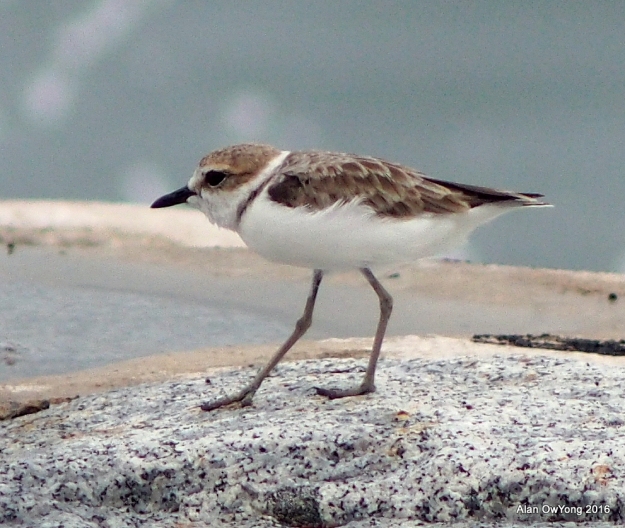Compiled by Alan OwYong and Yong Ding Li.

Granite seawall next to the Marina Barrage where the plovers are spending the winter.
We were fortunate that Loke Peng Fai found some Kentish, Charadrius alexandrinus, and Malaysian Plovers, Charadrius peronii, at the granite embankment next to the Marina Barrage on 24 Oct 2015 now that the access to Changi Cove was restricted. Not only that, a distinctive subspecies of the Kentish Plover were also spending the winter there together with a few Lesser Sand Plovers, Charadrius mongolus,. These are the Swinhoe’s or White-faced Plovers (ssp. dealbatus). This gives us an great opportunity to study them in different plumages close up as they can be rather difficult to identify as a result of their superficially similar plumage patterns.
Let’s start with our resident Malaysian Plovers first.
Malaysian Plovers are more sandy in appearance, and show more mottling on the upperpart. They also have paler legs and more extensive breast band. Both male and female have a white collar. The male has a black breast band while the female has a rufous band both extending over the neck. (Male left, Female right)
The Kentish Plovers also have the same white collars as the Malaysian. But they are duller brown with plainer and more uniform upperparts. The legs are darker and the breast band is also less extensive than that of the Malaysian Plover. Unlike the Malaysia Plover, the black breast band of the male does not extend fully around the neck.(Male left, Female right).

White-faced or Swinhoe’s Plover (spp. dealbatus)
The Swinhoe’s or White-faced Plovers is a rather distinct looking subspecies (ssp. dealbatus) of the Kentish Plover. It has a similar white collar and uniformly brown upperparts as the Kentish. But the breast band is often hardly noticeable and the broader white lores and brow gives it a white looking face.

Kentish and Lesser Plovers
The Lesser Sand Plover (behind) is 2 cm larger than the Kentish ( front) as can be seen from this photo. The key difference is the lack of a white collar for the Lesser Sand Plovers.

Which Plover is this?
Now that you are clear about the different features of the four small plovers, can you tell which plover is this? Better still can you tell the sex and age as well?
Reference: A field Guide to the Waterbirds of Asia. Wild Birds Society of Japan 1993.
Further reading on the spp dealbatus. “The Rediscovery of a Long-lost Charadrius Plover from South East Asia. Peter Kennerly, Dave Bakewell and Philip Round” at http://www.thaibirding.com/ornithology/lostplover.htm




